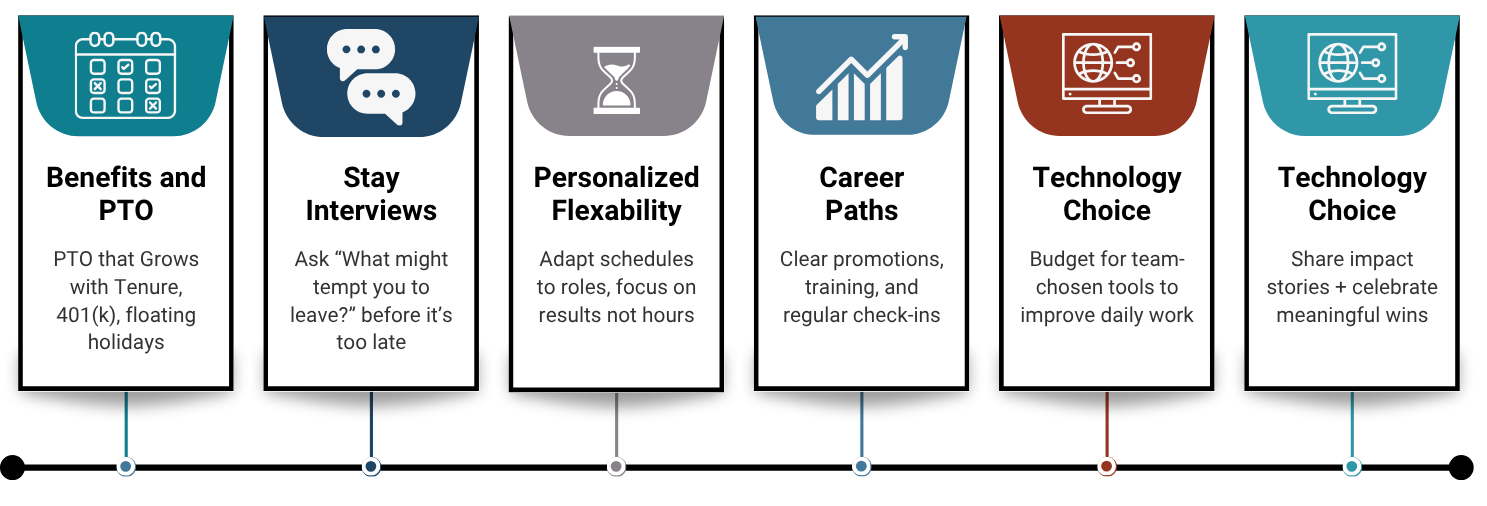How Do I Prevent Construction Turnover?
Implement targeted strategies, like competitive benefits packages, “stay interviews,” personalized flexibility, clear career paths, technology empowerment, and purpose-driven work environments—all of which have proven more effective than pay increases alone.
According to Bureau of Labor Statistics data, the construction industry's turnover rate remains significantly higher than the national average. With construction job openings at 264,000 positions nationwide and a 4.1% separation rate (compared to the 3.3% all-industry average), every contractor faces the challenge of keeping their best construction talent. Even more concerning is that the construction industry's quit rate of 2.2% indicates that construction employees are voluntarily leaving for better opportunities at a higher rate than most other industries.
"If you're losing on every job, you're not going to be able to retain good employees, period. Being able to apply good coaching and ensuring better financial performance during each project... that good performing contractor is going to have a sustainable business to repeat that and retain good employees." – Dan Nordin, Aspire Client
The True Cost of Employee Turnover
Let's be brutally honest and break down what each departure actually costs you:

These figures include obvious costs, such as recruiting and training, but also hidden expenses, including knowledge loss, reduced team productivity during transitions, potential damage to customer relationships, and lost business opportunities during staff shortages and training periods.
Six Construction Retention Strategies That Don't Require Massive Pay Increases

While fair compensation matters, employee departures aren't primarily driven by pay issues. Today's workers — particularly Millennials and Gen Z (who comprise 46% of the workforce) prioritize benefits, purpose, lifestyle, and healthy work environments alongside compensation.
1. Competitive Benefits and PTO
Traditional approach: Minimal or no benefits to keep costs down.
Retention approach: Structured benefits package that provides security and work-life balance.
IMPLEMENTATION BLUEPRINT:
- Offer health insurance options with company contribution
- Implement a paid time off (PTO) system that increases with tenure
- Consider retirement benefits like a Simple IRA or 401(k) with matching
- Develop innovative options like "time banks" or floating holidays for personal needs
INSIDER INSIGHT: Companies offering comprehensive benefits report 31% higher retention rates and receive 35% more qualified applicants.
2. Proactive Stay Interviews
Traditional approach: Wait until exit interviews to learn why people leave.
Retention approach: Conduct quarterly "stay interviews" with your most valuable team members.
IMPLEMENTATION BLUEPRINT:
- Schedule 30-minute quarterly one-on-ones focused specifically on employee retention
- Ask: "What would make this an even better place to work?"
- Ask: "What might tempt you to look elsewhere?"
- Document feedback and implement at least one suggestion
PROOF POINT: When implemented effectively, stay interviews are a valuable retention tool, providing a platform for employees to communicate and address concerns before they escalate.
3. Personalized Flexibility
Traditional approach: One-size-fits-all work schedules.
Retention approach: Individualized work arrangements based on role requirements.
IMPLEMENTATION BLUEPRINT:
- Audit which aspects of each role truly require specific hours/locations
- Create "flexibility" with options appropriate for different positions
- Focus evaluation on results rather than presence
4. Career Progression Clarity
Traditional approach: Vague promises of advancement "someday."
Retention approach: Clear growth pathways with specific milestones.
IMPLEMENTATION BLUEPRINT:
- Document clear advancement paths for each role
- Provide, encourage, and reimburse for training and relevant education
- Establish quarterly or annual skills development check-ins
- INSIDER INSIGHT: Teams with documented career paths experience 34% longer employee retention than those without clear advancement opportunities.
5. Technology Empowerment
Traditional approach: Top-down technology decisions focused on cost.
Retention approach: Involve team members in selecting tools that improve their work experience.
IMPLEMENTATION BLUEPRINT:
- Allocate an innovation budget per role ($300-500 annually)
- Prioritize tools that eliminate frustrating and/or manual tasks
6. Purpose Over Paycheck
Traditional approach: Focusing on what you build.
Retention approach: Emphasize the importance of why it matters.
IMPLEMENTATION BLUEPRINT:
- Collect and share customer stories about how your work improved their lives
- Create team success celebrations for project completions with clear impact statements
"Having good margins really allows us to hire qualified people and give them the benefits they deserve. We live in a very small area where there's not a large pool of employees. Being able to provide them with a 401K and health insurance and a good hourly wage so that they can provide for their families, taking care of their future is important to us. And the only way that we can do that is if we're a margin-based business." – Cheryl Nelson, Aspire Client
Your 90-Day Retention Action Plan 
Don't try implementing all six strategies at once. Lasting change comes not from crash-diet approaches but from fundamental business transformations.
- Assessment: Conduct anonymous team survey to identify your biggest retention vulnerabilities
- Prioritization: Select the two strategies most likely to address your specific challenges
- 90-Day Sprint: Implement those two strategies completely before moving to others
- Measurement: Track retention rates, referrals, and team satisfaction scores
THE BOTTOM LINE
The construction companies that will dominate the next decade are the ones who master the art of keeping their best people by building a loyal team that stays, grows, and refers other quality candidates to your company. Remember: in today's market, employee retention isn't just an HR function—it's a COMPETITIVE ADVANTAGE.
Need help implementing a retention strategy that works? Contact Aspire to learn how our business coaching has helped contractors reach the next levels of profitability so they can afford to hire, retain, and reward the best talent.

